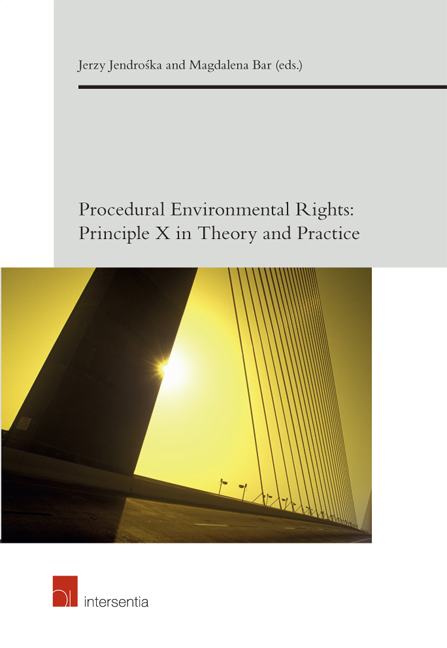Book contents
- Frontmatter
- Contents
- Introduction Procedural Environmental Rights in Theory and Practice
- Procedural Environmental Rights: Status and Developments
- Procedural Environmental Rights in Practice
- Public Participation
- Access to Justice
- Procedural Environmental Rights and Nature Protection
- Towards a Legally Enforceable Duty to Restore Endangered Species under EU Nature Conservation Law – On Wild Hamsters, the Rule of Law and Species Extinction
- Recognition of Rights of Nature, as a Subject of Law, in the International Environmental Law Framework
- Strengthening Conservation through Participation: Procedural Environmental Rights of Local Communities in Transboundary Protected Areas
- Procedural Environmental Rights and EIA
- Procedural Environmental Rights and Climate Change
Recognition of Rights of Nature, as a Subject of Law, in the International Environmental Law Framework
from Procedural Environmental Rights and Nature Protection
Published online by Cambridge University Press: 12 October 2018
- Frontmatter
- Contents
- Introduction Procedural Environmental Rights in Theory and Practice
- Procedural Environmental Rights: Status and Developments
- Procedural Environmental Rights in Practice
- Public Participation
- Access to Justice
- Procedural Environmental Rights and Nature Protection
- Towards a Legally Enforceable Duty to Restore Endangered Species under EU Nature Conservation Law – On Wild Hamsters, the Rule of Law and Species Extinction
- Recognition of Rights of Nature, as a Subject of Law, in the International Environmental Law Framework
- Strengthening Conservation through Participation: Procedural Environmental Rights of Local Communities in Transboundary Protected Areas
- Procedural Environmental Rights and EIA
- Procedural Environmental Rights and Climate Change
Summary
ABSTRACT
The present article aims to analyse the foremost theoretical foundations that support the recognition of Nature, as a subject of international law and a holder of rights, as a legitimate, independent, representative and more enforcing mechanism to stop the environmental depletion. It will also tackle a brief description about the initial conditions to acknowledge the legal intervention of Mother Earth as an actor within the international community.
KEYWORDS
Holder of rights; Legal standing; Mother Earth; Nature; Subject of international law
INTRODUCTION
One of the most remarkable achievements attained during the last Conference of the Parties on the Framework Convention on Climate Change – carried out from 30 November to 11 December 2015 – was the commitment of ‘[h]olding the increase in the global average temperature to well below 2 °C above pre-industrial levels and to pursue efforts to limit the temperature increase to 1.5 °C […]’, as an explicit objective of the ‘Paris Agreement’.
Certainly, it was not the first time that nations had subscribed these kinds of commitments, given they already agreed to achieve ‘[…] stabilization of greenhouse gas concentrations in the atmosphere at a level that would prevent dangerous anthropogenic interference with the climate system’, by means of the subscription of the original Framework Convention on Climate Change in 1992. Likewise, through the Kyoto Protocol of 1997, they agreed to ‘[…] ensure that their aggregate anthropogenic carbon dioxide equivalent emissions of the greenhouse gases […] do not exceed their assigned amounts, calculated pursuant to their quantified emission limitation and reduction commitments […]’
Nevertheless, it seems that these legal mechanisms have not been sufficiently effective to achieve the expected results, above all if one notices that ‘[m]ost of the warming occurred in the past 35 years, with 16 of the 17 warmest years on record occurring since 2001’, according to the National Aeronautics and Space Administration (NASA), which is due to the fact that ‘[…] recent anthropogenic emissions of greenhouse gases are the highest in history, inter alia. Therefore, it is curious how difficult it has been to enforce international law, despite the widely known environmental repercussions of global warming on air temperature, precipitation, sea level, water and carbon cycles, and associated ecosystems, among other worldwide threats.
- Type
- Chapter
- Information
- Procedural Environmental RightsPrinciple X in Theory and Practice, pp. 341 - 362Publisher: IntersentiaPrint publication year: 2018



